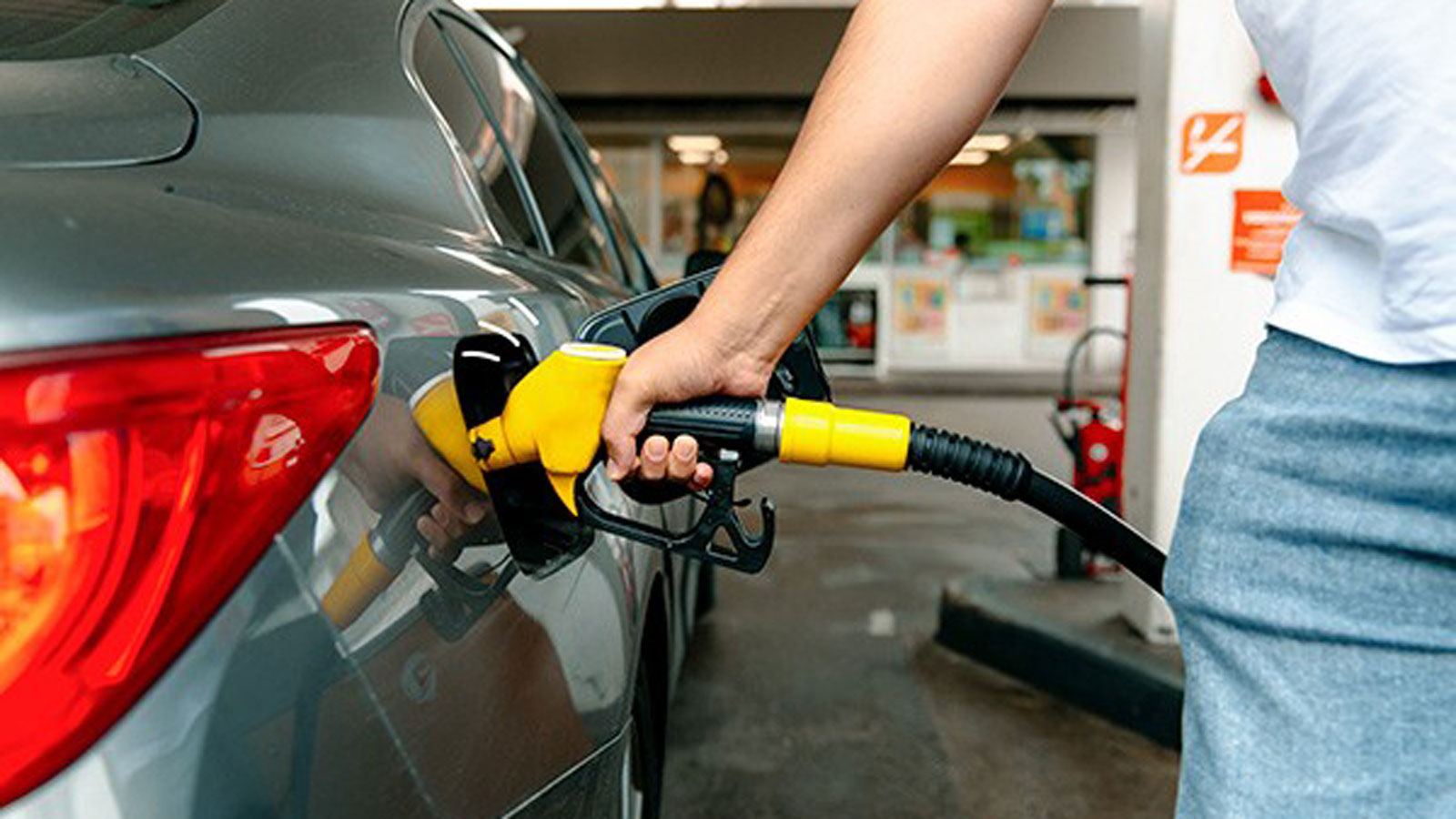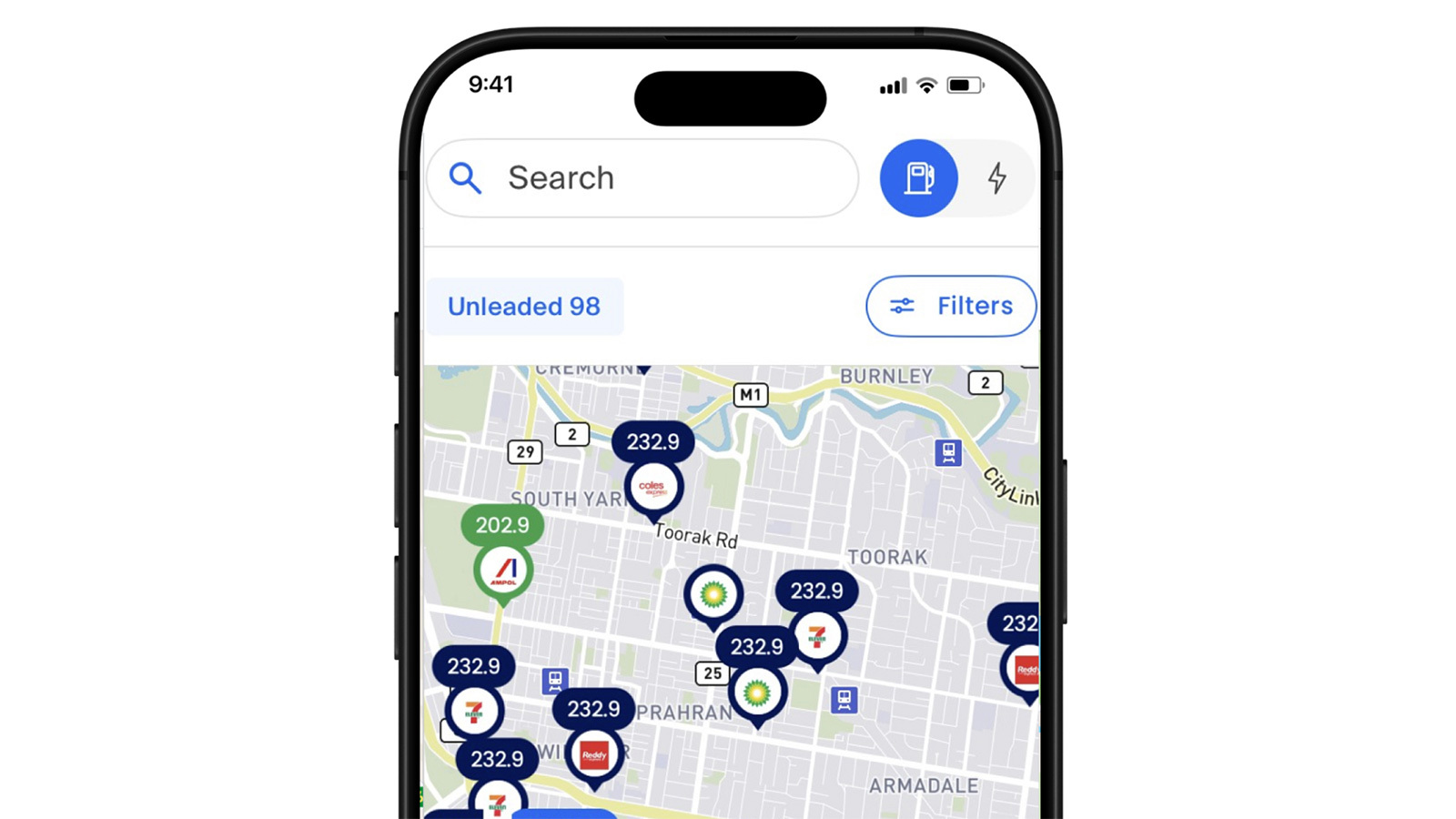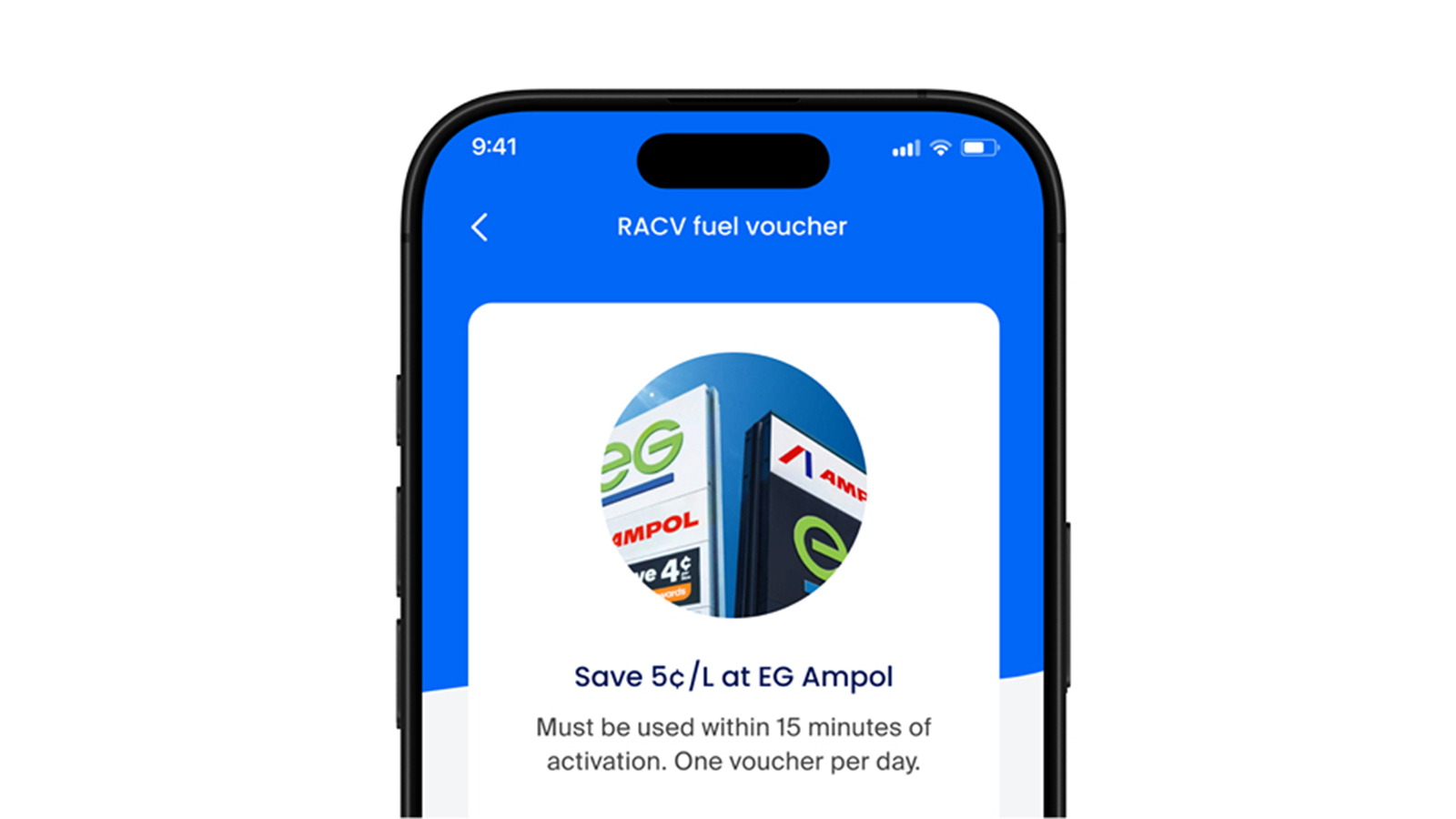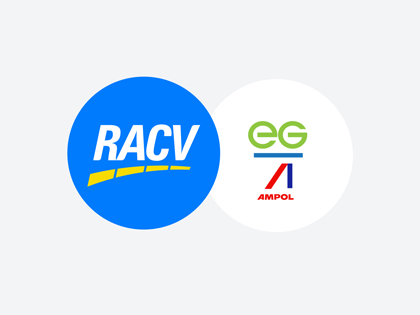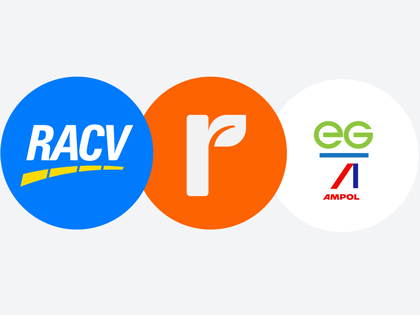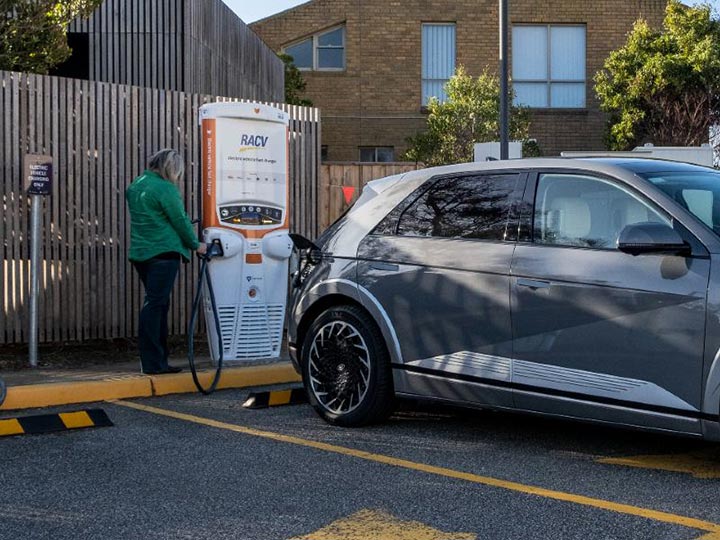Scan your RACV fuel voucher to get 2¢/L
+ 4¢/L by scanning your Woolworths shopping voucher or Everyday Rewards card after spending $30 or more~
Stack discounts to save more
Save up to 10c per litre by stacking the RACV fuel voucher with Everyday Rewards and EG Ampol discounts.

Save 6¢/L~~
Frequently asked questions
RACV Members can access one fuel voucher per day via the RACV App. When planning to use the voucher, first fill up on fuel at any EG Ampol station. Once you’re in line to pay at the register, open your app, click on the ‘fuel voucher’ on the homepage screen, then click ‘activate voucher’. You’ll have 15 minutes for the cashier to scan your voucher before it expires.
Did this answer your question?
Thank you for your feedback
Thank you for your feedback
The fuel prices in the app are updated every 15 minutes, based on information provided by the fuel stations. It’s up to the fuel providers to ensure the information is correct and up-to-date.
Did this answer your question?
Thank you for your feedback
Thank you for your feedback
It sure does. You can use our fuel finder to find Chargefox electric vehicle charging stations across Australia. RACV Members also save 10% on ultra-rapid charging, which charges some vehicles to 80% in just 15 minutes.
Did this answer your question?
Thank you for your feedback
Thank you for your feedback
You’ll get one fuel voucher to use once every day.
Did this answer your question?
Thank you for your feedback
Thank you for your feedback
You can download the RACV App from the Apple Store or Google Play.
Did this answer your question?
Thank you for your feedback
Thank you for your feedback
The RACV App is for RACV Members, so they can access member benefits and fuel vouchers, compare fuel prices, call emergency roadside assistance, make a claim, update details, manage products and services, and make payments.
Did this answer your question?
Thank you for your feedback
Thank you for your feedback
The RACV App lets members:
- access member benefits
- access fuel vouchers
- compare fuel prices
- find EV charging stations
- call emergency roadside assistance
- make a claim
- update account details
- manage RACV products and services
- and, make payments
all from the convenience of their mobile device.
Did this answer your question?
Thank you for your feedback
Thank you for your feedback
Explore tips and articles
Terms and conditions
- The RACV and EG Ampol offer is: available to all active RACV Members (residential and small business) who have a My Account login and can access the RACV Offer page. To access the Offer as part of the benefits program you will need to scan the fuel discount barcode presented via the RACV link when paying for your fuel at EG Ampol co-branded service stations. Alternatively, you can scan your valid RACV Membership Card in-store at an EG Ampol co-branded service stations register to access the offer as part of the loyalty program when using your personal smart device or tablet with Wi-Fi or mobile internet connection.
- Validated RACV Members are eligible for one of two values (cents off per litre) of the fuel discount dependent on whether the offer is:
a. Stacked with the Woolworths supermarket fuel discount and EG Woolworths in-store discount. If stacked, the discount will be a 2 cent per litre fuel discount on all petrol and diesel products (excluding LPG) at all EG Ampol co-branded service stations operated by EG Group in Australia (or such other discount as may be notified to you from time to time).
b. The Offer consists of a 2 cent per litre RACV Member fuel discount on all petrol and diesel products (excluding LPG) at all EG Ampol co-branded service stations operated by EG Group in Australia (or such other discount as may be notified to you from time to time).
c. The Offer is available once per calendar day per member, up to a maximum of 150 litres per fill.
d. The Offer will be available in conjunction with (i.e. can be combined with and “stacked” on top of) the following existing fuel discounts available at EG Ampol co-branded fuel service stations:
(a) ^4c per litre Woolworths supermarket fuel discount voucher offer, and
(b) ~In-store spend 4c per litre discount when the member spends $5 or more in-store, further details of which are set out below. The Offer is not available in conjunction with any other offer.
e. The Offer is not available in conjunction with the following fuel cards: Motorpass, Motorcharge, FleetCard, AmpolCard, StarCard or EG Fuel Card.
f. Used on its own, the RACV Member discount will be a 5 cent per litre fuel discount on all petrol and diesel products (excluding LPG) at all EG Ampol co-branded service stations operated by EG Group in Australia (or such other discount as may be notified to you from time to time).
g. The Offer consists of a 5 cent per litre fuel discount on all petrol and diesel products (excluding LPG) at all EG Ampol co-branded service stations operated by EG Group in Australia (or such other discount as may be notified to you from time to time).
h. The Offer is available once per calendar day per member, up to a maximum of 150 litres per fill.
i. The Offer is not available in conjunction with any other offer.
- Save up to 10c per litre - RACV Members
Save up to 10c per litre fuel offer consists of:
a. 2c per litre from the RACV and EG Ampol offer
b. 4c per litre Woolworths supermarket fuel discount^ voucher offer and;
c. 4c per litre EG Woolworths in-store discount~ when the member spends $5 or more instore
Each discount is available separately or in combination with one or both of the other two discounts. All offers redeemable on a maximum petrol purchase of 150 litres.
- Save 5c per litre - RACV Members
Save 5c per litre fuel offer consists of:
5c per litre from the RACV and EG Ampol offer
This offer is redeemable on a maximum petrol purchase of 150 litres. The Offer is not available in conjunction with any other offer
- EG Ampol co-branded Service Stations
EG Ampol co-branded locations can be found using our store locator: https://www.eg-australia.com/eg-store-locator/ or via the EG Club App. A EG Ampol co-branded location has either Woolworths (but not Metro or Metro Go) branding or EG branding on the shop front.
- 4c Per Litre Supermarket Fuel Discount Voucher Offer
To receive a fuel discount of 4c per litre, spend $30 or more (excluding purchases of gift cards, lottery, smoking products, carpet care, donations, travel cards, tickets and delivery charges) in one transaction at a participating Woolworths Supermarket or Metro and present your fuel discount receipt or scan your registered Everyday Rewards card within 28 days from issue at any EG Ampol co-branded service stations. The discount may only be used in a single transaction for a fuel purchase of up to 150 litre
- Instant 4c In-store Fuel Discount Offer
To receive an additional fuel discount of 4c per litre, spend $5 or more in one transaction in-store at a EG Ampol co-branded service stations. Purchases of fuel (including petrol, diesel and LPG grades), AdBlue at the pump, Telecommunications (including Mobile & Internet Recharge, Handsets and Starter Kits), gift cards (including iTunes cards), AmpolCash, lottery, smoking products and accessories and cash-outs are excluded from the qualifying purchase amount. The discount must be redeemed immediately and may only be used in a single transaction for a fuel purchase of up to 150 litres.
~ To receive a fuel discount of 4c per litre, spend $30 or more (excluding purchases of gift cards, lottery, smoking products, carpet care, donations, travel cards, tickets and delivery charges) in one transaction at a participating Woolworths Supermarket or Metro and present your fuel discount receipt or scan your registered Everyday Rewards card within 28 days from issue at any EG Ampol co-branded service stations#. The discount may only be used in a single transaction for a fuel purchase of up to 150 litres.
^ To receive an additional fuel discount of 4c per litre, spend $5 or more in one transaction in-store at a participating EG Ampol co-branded service stations. Purchases of fuel (including petrol, diesel and LPG grades), AdBlue at the pump, Telecommunications (including Mobile & Internet Recharge, Handsets and Starter Kits), gift cards (including iTunes cards), AmpolCash, lottery, smoking products and accessories and cash-outs are excluded from the qualifying purchase amount. The discount must be redeemed immediately and may only be used in a single transaction for a fuel purchase of up to 150 litres.
*To receive a fuel discount of 5¢ per litre at EG Ampol co-branded service stations in Australia, eligible RACV Members must download the discount fuel barcode from the RACV Fuel Voucher webpage or scan their valid RACV Membership card. Offer is available once per calendar day per customer, up to a maximum of 150 litres per fill. Offer excludes LPG. Discount not available with any other fuel card. For full terms and conditions visit the website.
~~To receive the RACV Member fuel discount at EG Ampol co-branded service stations in Australia, eligible RACV Members must download the discount fuel barcode from RACV or scan their valid RACV Membership card. Offer is available once per calendar day per customer, up to a maximum of 150 litres per fill. Offer excludes LPG. Discount not available with any other fuel card. Offer is available in conjunction the existing Woolworths Everday Rewards discount available at EG Ampol co-branded service stations to receive up to 6¢ off per litre. (a) 2¢ per litre RACV Membership fuel voucher or scanning their RACV Membership card in-store, and (b) ~4¢ per litre Woolworths supermarket fuel discount voucher and Woolworths Everyday Rewards Card offer. The offer is not available with any other offer. For full terms and conditions visit our website.
^^To receive the RACV Member fuel discount at EG Ampol co-branded service stations in Australia, eligible RACV Members must download the discount fuel barcode from RACV or scan their valid RACV Membership card. Offer is available once per calendar day per customer, up to a maximum of 150 litres per fill. Offer excludes LPG. Discount not available with any other fuel card. Offer is available in conjunction the existing EG Ampol fuel discounts available at EG Ampol co-branded service stations to receive up to 9¢ off per litre. (a) ^In-store spend 4¢ per litre when the customer spends $5 or more in-store. The offer is not available with any other offer. For full terms and conditions visit our website.
**To receive the RACV Member fuel discount at EG Ampol co-branded service stations in Australia, eligible RACV Members must download the discount fuel barcode from RACV or scan their valid RACV Membership card. Offer is available once per calendar day per customer, up to a maximum of 150 litres per fill. Offer excludes LPG. Discount not available with any other fuel card. Offer is available in conjunction the following existing fuel discounts available at EG Ampol co-branded service stations to receive up to 10¢ off per litre: (a) 2¢ per litre RACV Membership fuel voucher or scanning their RACV Membership card in-store, and (b) ~4¢ per litre Woolworths supermarket fuel discount voucher offer, and (c) ^In-store spend 4¢ per litre when the customer spends $5 or more in-store. The offer is not available with any other offer. For full terms and conditions visit our website.
* The Offer: 10% off the Retail Charging Price at all Chargefox ultra-rapid sites. The Offer only applies to the Retail Charging Price. Other fees and charges may apply. The Offer is only available at participating Chargefox ultra-rapid sites. For participating locations please download the Chargefox app. Where an RACV Member is also entitled to a discount via a vehicle manufacturer partnership with Chargefox (see here), they will receive a minimum of 50% off the Retail Charging Price. The Offer can only be activated by current RACV Members who have completed the following steps prior to charging their vehicle:
(a) Downloaded or updated the Chargefox app (on a compatible smartphone).
(b) Logged into the Chargefox app and added their credit card information and a valid RACV Membership number in their profile.
Discounts cannot be applied after a charge session has begun or has been completed. The Offer may be withdrawn at any time and without notice. RACV accepts no responsibility in respect to any damage or loss to a member caused through their use of, or lack of availability of Chargefox equipment to charge their vehicle. Members should review the Chargefox terms and conditions and privacy policy.
These terms and conditions are subject to change from time to time. Please read the latest RACV Member benefits terms and conditions. View a copy of Chargefox’s full terms and conditions.
#The RACV Fuel member benefit is subject to change. Please read the terms and conditions.
